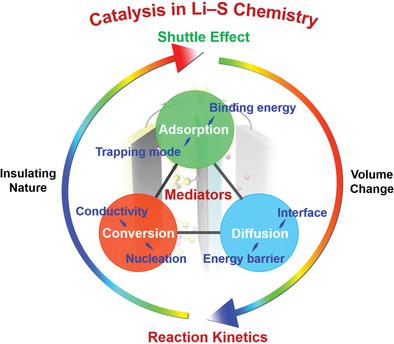当前位置:
X-MOL 学术
›
Adv. Energy Mater.
›
论文详情
Our official English website, www.x-mol.net, welcomes your
feedback! (Note: you will need to create a separate account there.)
Rationalizing Electrocatalysis of Li–S Chemistry by Mediator Design: Progress and Prospects
Advanced Energy Materials ( IF 24.4 ) Pub Date : 2019-07-12 , DOI: 10.1002/aenm.201901075 Yingze Song 1, 2 , Wenlong Cai 3 , Long Kong 4 , Jingsheng Cai 1 , Qiang Zhang 4 , Jingyu Sun 1
Advanced Energy Materials ( IF 24.4 ) Pub Date : 2019-07-12 , DOI: 10.1002/aenm.201901075 Yingze Song 1, 2 , Wenlong Cai 3 , Long Kong 4 , Jingsheng Cai 1 , Qiang Zhang 4 , Jingyu Sun 1
Affiliation

|
The lithium–sulfur (Li–S) battery is regarded as a next‐generation energy storage system due to its conspicuous merits in high theoretical capacity (1672 mAh g−1), overwhelming energy density (2600 Wh kg−1), and the cost‐effectiveness of sulfur. However, the practical application of Li–S batteries is still handicapped by a multitude of key challenges, mainly pertaining to fatal lithium polysulfide (LiPS) shuttling and sluggish sulfur redox kinetics. In this respect, rationalizing electrocatalytic processes in Li–S chemistry to synergize the entrapment and conversion of LiPSs is of paramount significance. This review summarizes recent progress and well‐developed strategies of the mediator design toward promoted Li–S chemistry. The current advances, existing challenges, and future directions are accordingly highlighted, aiming at providing in‐depth understanding of the sulfur reaction mechanism and guiding the rational mediator design to realize high‐energy and long‐life Li–S batteries.
中文翻译:

通过介体设计合理化Li-S化学的电催化作用:进展和展望
锂硫(Li–S)电池由于其在高理论容量(1672 mAh g -1),压倒性能量密度(2600 Wh kg -1)方面的突出优势而被视为下一代能量存储系统。),以及硫磺的成本效益。但是,Li-S电池的实际应用仍然受到许多关键挑战的阻碍,主要涉及致命的多硫化锂(LiPS)穿梭和硫氧化还原动力学迟缓的问题。在这方面,合理化Li-S化学中的电催化过程以协同LiPSs的俘获和转化是至关重要的。这篇综述总结了调解剂设计在促进Li-S化学方面的最新进展和完善的策略。相应地强调了当前的进展,存在的挑战和未来的方向,旨在深入了解硫反应机理,并指导合理的介体设计以实现高能量和长寿命的Li-S电池。
更新日期:2020-03-19
中文翻译:

通过介体设计合理化Li-S化学的电催化作用:进展和展望
锂硫(Li–S)电池由于其在高理论容量(1672 mAh g -1),压倒性能量密度(2600 Wh kg -1)方面的突出优势而被视为下一代能量存储系统。),以及硫磺的成本效益。但是,Li-S电池的实际应用仍然受到许多关键挑战的阻碍,主要涉及致命的多硫化锂(LiPS)穿梭和硫氧化还原动力学迟缓的问题。在这方面,合理化Li-S化学中的电催化过程以协同LiPSs的俘获和转化是至关重要的。这篇综述总结了调解剂设计在促进Li-S化学方面的最新进展和完善的策略。相应地强调了当前的进展,存在的挑战和未来的方向,旨在深入了解硫反应机理,并指导合理的介体设计以实现高能量和长寿命的Li-S电池。











































 京公网安备 11010802027423号
京公网安备 11010802027423号